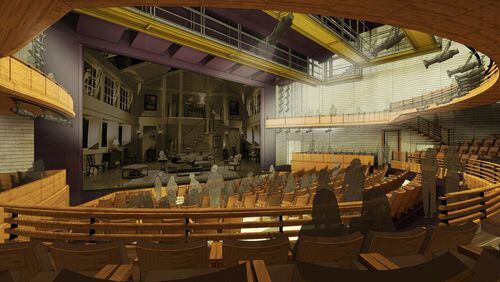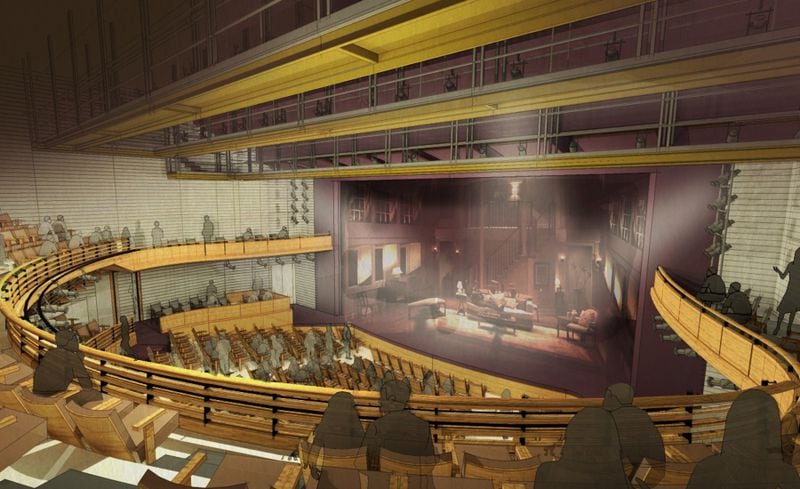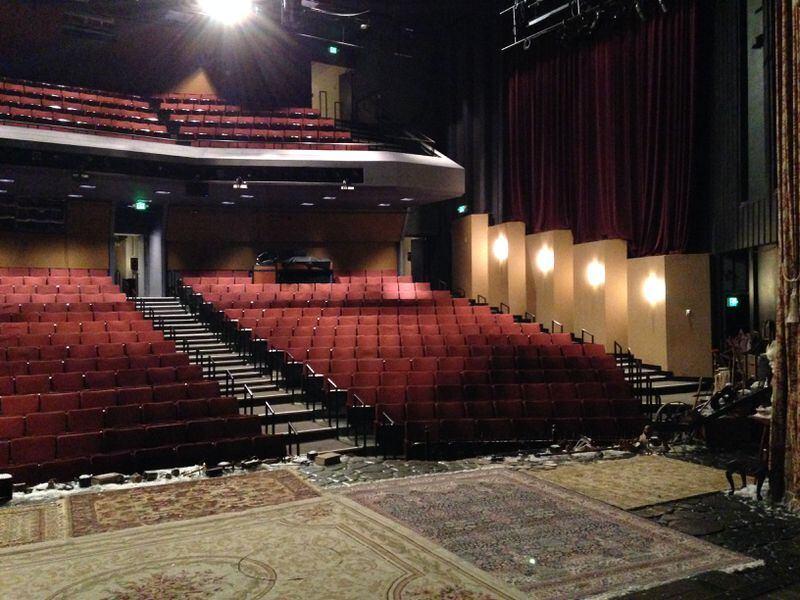Credit: hpousner
Credit: hpousner
The nine-week Atlanta Symphony Orchestra lockout spawned its fair share of conspiracy theories about orchestra and Woodruff Arts Center management among supporters of the musicians, often spurred by frequent accusation-filled statements released by the ASO Players’ Association.
So it wasn't surprising that there was speculation on arts blogs about the timing of the Dec. 5 announcement that the arts center was receiving a $38 million gift from the Robert W. Woodruff Foundation.
Arts Center president and CEO Virginia Hepner was quick to assert that the timing of the grant — including $25 million in endowment matching funds and $13 million for capital improvements — had everything to do with the nonprofit taking care of business.
Credit: hpousner
Credit: hpousner
Throughout the lockout, she and other Woodruff officials said that foundation leaders had pushed the arts center had to create a “sustainable” business model for the ASO after it finished a dozen consecutive years with deficits.
Asked on the day the $38 million gift was announced if the Woodruff Foundation was among those who told the arts center — the parent group over the orchestra, Alliance Theatre, High Museum of Art and Arts for Learning — that its access to grants would suffer without major corrections, Hepner said, “Without question.
“Very good foundations try to make sure that their recipients have a good business plan to support the artistic plan,” Hepner said. “It’s not only the Woodruff Foundation but many other important foundations have said repeatedly that we will continue to support the arts center and their particular passion at the arts center, but you have to make sure you manage (it). And that’s true of all the divisions.”
Hepner said she and Woodruff Foundation officials began discussing what became the largest gift in the Midtown arts center’s 46-year history shortly after she took her leadership role.
“I’ve been here about about two and a half years and we started talking about it two and a half years ago,” Hepner said, “and I would say seriously in the past year, at least – all of us needing to be clear on what had to happen.”
The four-year collective bargaining agreement finally hammered out between Woodruff and ASO management and the Players' Association on Nov. 8 calls for the orchestra, which was reduced from 88 full-time musicians in its 2012 contract to 77 this season, to grow to 88 by the new pact's end.
The $25 million endowment matching funds, which the ASO will share equally with the Alliance and High, strongly positions the orchestra to add back the 11 player positions required in the contract if the Woodruff Foundation grant can be matched. The cost to endow a musician’s chair in perpetuity is $2 million to $2.5 million.
However, all that shouldn’t obscure the fact that the biggest winner in the grant news is the Alliance Theatre, which will receive most of the $13 million earmarked for capital improvements in addition to its share of the endowment funds. The capital improvement funds, which do not require a match, will be the lead gift in a planned $30 million complete renovation of Alliance Theatre performance, education and public spaces that have not been significantly upgraded since the Memorial Arts Center (now Memorial Arts Building) opened in 1968.
In the renovation projected for a late 2018 completion, the auditorium will be modified to make the space more intimate, bringing patrons closer to the stage. Sound and lighting equipment will be modernized and acoustics greatly improved. Multipurpose rehearsal and support spaces will be added.
“We’ll be able to have those artist-support facilities that take the right care of the caliber of artists that we have the luxury to work with,” Alliance artistic director Susan V. Booth said. “We can’t exist without the artists on our stage, without the technicians behind the stage, without the stitchers in our costume shop. So we need to provide facilities that are as excellent as the work that they do.”
Credit: hpousner
Credit: hpousner
ORIGINAL REPORT, PUBLISHED ON DEC. 6
Woodruff Foundation gives Woodruff Arts Center $38 million grant
The Woodruff Arts Center has received a major early Christmas gift, announcing Friday that the Robert W. Woodruff Foundation has given it a $38 million grant.
The largest gift in the Midtown art center’s 46-year history includes $25 million in endowment matching funds — with support to add full-time musician positions for the Atlanta Symphony Orchestra — and $13 million for capital improvements. Those capital funds, which do not require a match, will be the lead gift in a $30 million complete renovation of Alliance Theatre performance, education and public spaces.
The renovation will be so major for the Alliance in the Memorial Arts Building, spaces that have not significantly changed since the structure opened in 1968, that the theater will have to secure a temporary home for at least one season.
The news is a jolt of positive news for the Woodruff after a bruising nine-week lockout of ASO musicians this fall. The second lockout in two years sparked harsh criticism from the players and their supporters of the orchestra’s stewardship by arts center administrators and board members. Passions became so operatic that some Atlantans even called for the ASO to secede from the Woodruff, the non-profit that also oversees the Alliance, High Museum of Art and the children’s educational group Arts for Learning.
“There’s no question in my mind that this is an affirmation of how important the Woodruff Arts Center is to Atlanta and to the people who have been funding us and are very willing and excited to continue that,” arts center president and CEO Virginia Hepner said Friday. “I hope this message is clear: that the people who haven’t really been buying tickets or memberships or sending donations really need to express their support now.”
Management said it had no choice, in balancing the present and future operating needs of the ASO with those of its other divisions, but to seek further musician concessions after the orchestra ended 12 consecutive years with deficits. That included $2 million in fiscal 2014.
Hepner and other leaders repeatedly asserted that there was great potential support for the ASO in particular, and the Woodruff in general, if all the divisions could achieve balanced budgets. On Friday, she said the Woodruff Foundation, which shares a name with the arts center but operates independently and with a much broader mission than the arts, was among those suggesting that a balanced ASO budget would lead to greater largess.
The four-year collective bargaining agreement finally hammered out between Woodruff and ASO management and the Players’ Association on Nov. 8 calls for the orchestra, which was reduced from 88 full-time musicians in the 2012 agreement to 77 this season, to grow back to 88 by the pact’s end.
The $25 million endowment matching funds, which the ASO will share equally with the Alliance and High, obviously positions the orchestra to reach that contracted requirement if the Woodruff Foundation grant can be matched.
Hepner said Friday that another entity already has pledged to endow one of the musician positions and others have expressed interest. The cost to endow a chair in perpetuity is $2 million to $2.5 million.
The bigger question is if the arts center can raise the $25 million match at the same time as it and its divisions raise millions for operations — the goal is $32.6 million in fiscal 2015, for instance.
The Woodruff Foundation has not set a deadline for the match to be achieved. However, Hepner said the informal, “self-imposed” goal is two years. She believes the funds are available in Atlanta and said Woodruff leaders will be aggressive in pursuit of them.
“We wouldn’t launch a campaign like this if we didn’t think (success was attainable),” she said. “A lot of things help: The organization is on a much stronger footing than we were two years ago and the economy seems to have improved. I believe the (arts center) staff is even more equipped to support the artistic leadership in making the appropriate asks of donors who I think very much identify with their vision.”
Alliance Theatre Artistic Director Susan V. Booth long has had a vision, but not funding, for a primary performance space “that supports who we are now and who we aspire to be.”
She called the existing facility an “architectural conceit,” designed before the resident theater troupe had fully formed. The theater space was built as part of the Memorial Arts Center in response to the fatal 1962 crash of a chartered plane full of Atlanta’s arts community leaders near Orly Field outside Paris.
Booth said the renovation will transform the auditorium into a place “that absolutely embraces the audience as a community that is sharing the event with one another as well as with the artists.” That means that the hulking orchestra pit that Alliance staffers refer to as “the moat” will be reduced to bring audiences in closer proximity to the actors in more intimate stagings. In another enhancement, balcony patrons will have access to that level inside the theater instead of having to climb stairs outside it, across the Galleria lobby. Acoustics will be improved so that “you can hear a pin drop without amplification,” Booth said.
Behind the scenes, the renovation will afford the theater its first catwalk to hang massive lighting equipment, and will update high-mileage support spaces from the costume shop to dressing rooms.
The physical improvements planned for the Alliance are phase one of a yet-to-be-announced long-term plan to improve the Memorial Arts Building’s public and performance spaces. Woodruff officials hope to complete the Alliance renovation project by the end of 2018. Hepner said plans for Symphony Hall are not firm and subject to change.
Booth said the more than $8 million in Woodruff Foundation endowment matching funds are equally important to her as the Alliance’s facilities gift. “It allows us to continue to risk, to continue to dream and to do so in a way that provides the safety net to know that we’re going to be around in another generation and not risk the health of our organization.”
That’s important because, while the Alliance has finished four consecutive years in the black, it has run deficits four times over Booth’s 13-year run at the helm.
The funding is an obvious boost for its parent non-profit as well. In part because of the ambitious $124 million expansion of the High Museum not long before the 2008 recession, the art center’s debt has tripled since 2001, now at $173 million.
Woodruff spokesman Randy Donaldson said the arts center has a detailed strategy for retiring its long-term debt and will be “opportunistic” in reducing debt when possible.
“Yes, we believe we will be able to reach out to the community successfully for support for both capital and endowment campaigns while effectively managing our debt obligations,” he said.
About the Author









